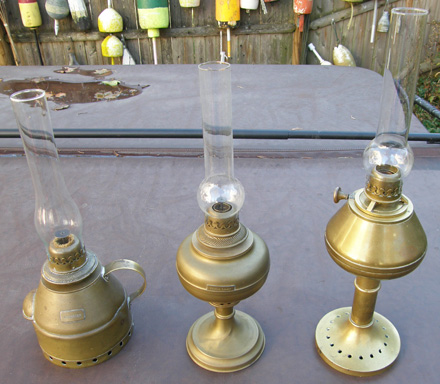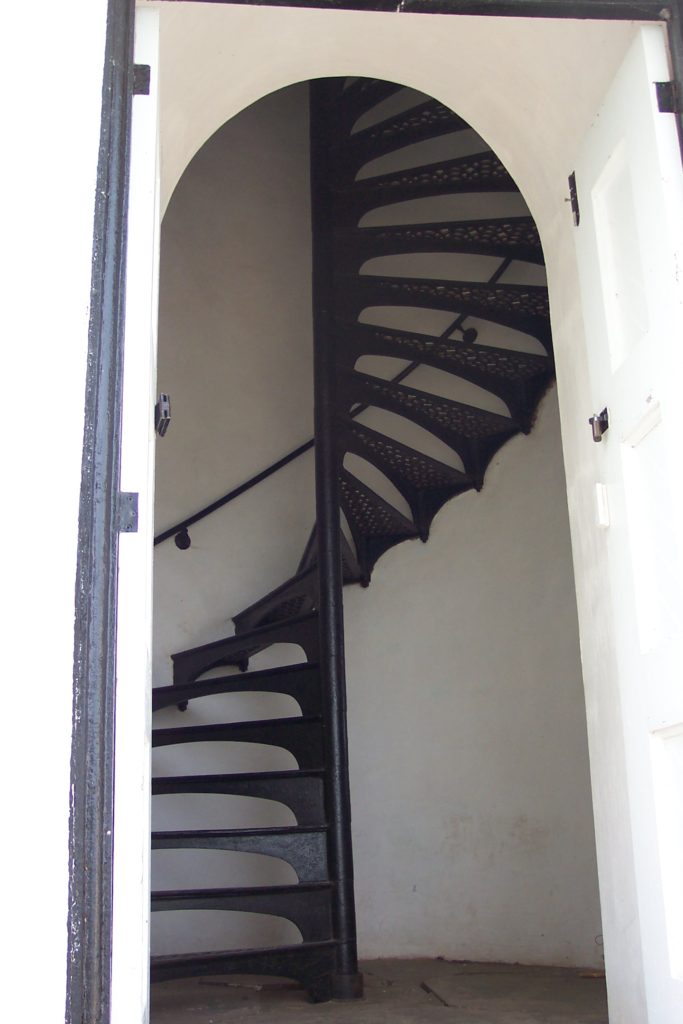A common image of the old-time light keeper conjured up for the visitor by far too many well-meaning lighthouse tour guides is that of the weary keeper struggling up the spiral stairs time after time lugging a heavy can of fuel oil up to the lantern. Folklore it is, but is it factual?
The three photos above show typical “spiral” staircases, as are found in most, but not all, lighthouses. The keepers would likely have made many trips a day up and down in the carrying out of their duties. On some trips they would have been taking up oil for the lamp(s), but how much and how often?
I recall reading an article that quoted a lighthouse tour guide telling visitors, “they [keepers] were able to carry a TEN gallon container of oil, weighing some remarkable total pounds, more than ten times daily to the top of the tower.” In my own lighthouse travels, I have often heard a similar story although usually with reference to a five gallon can of oil, rather than a ten-gallon, being carried up at least once each day.
I have doubts that this was ever done, nor that it was necessary. Kerosene weighs about 6.9 pounds per gallon. Thus a ten gallon can would weigh about 69 pounds, plus a few pounds for the can itself. No keeper smaller than Paul Bunyan would have been able to carry that kind of load up the stairs. Even the smaller five gallon can, a more plausible 35 pound load, being carried up into the lantern daily seldom happened.
But let’s presume for a moment that it did, that the tale told by the guide mentioned above is true, and that a keeper did carry a ten-gallon can up the stairs ten times a day. What would the keeper do with all that oil? That would be one hundred gallons of oil going up per day, seven hundred gallons per week. There isn’t room for a 100-gallon fuel tank, much less a 700-gallon tank, in most lighthouse watch-rooms that I’ve ever been in. Surely there isn’t space for it in the lantern either. Considering the amount of oil actually burned by a lamp inside a Fresnel lens, most of those 700 gallons would have been unneeded.
Just how much oil was required per night? There are at least two relevant factors. One factor was the size (order) of the Fresnel lens, which determined the size of the lamp. Lamps used in larger lenses had more wicks than those used in smaller sizes. The more wicks, the more oil was used. The other relevant factor is the length of time the lamp was lit. Winter nights are long; summer nights are short. The Lighthouse Friends website (www.lighthousefriends.com), in the entry for the Boon Island, Maine, light, includes a chart showing fuel consumption of lamps used in various sizes of Fresnel lenses. According to this chart, a 1st order lens used 26.25 ounces of kerosene per hour in a 4-wick lamp, a 2nd order lens used 17.5 ounces per hour in a three wick lamp, and a 3rd order lens used 7.0 ounces per hour in a two wick lamp. Lamps in smaller lenses used even less.
The lighthouse where the tour guide noted above told the tale, had (and still has) a third order Fresnel lens. The chart states that the two-wick lamp used in this size lens consumed only seven ounces of kerosene per hour. Thus on a long winter night (assume the lamp burned for 15 hours), it would have consumed 105 ounces (0.8 gallons) of kerosene. On a short summer night (assume the lamp burned for 8 hours), it would have consumed only 56 ounces (0.4 gallons) of kerosene.
In a winter week’s time, the lamp would have consumed 5.7 gallons of kerosene. Remember the keeper had supposedly lugged 700 gallons up the stairs that week, leaving a surplus of 694.3 gallons of fuel. A week later, there would have been 1,388.6 gallons of extra kerosene up in the lighthouse tower. See what I mean? Pretty soon something was going to overflow!
Just for fun, let’s do the math for the 4-wick lamp that the chart states was used in a first order Fresnel lens. This lamp consumed 26.25 ounces of kerosene per hour. On a long winter night (again, assume the lamp burned for 15 hours), it would have consumed 394 ounces ( 3.1 gallons) of kerosene. On a short summer night (assume the lamp burned for 8 hours), it would have consumed 210 ounces (1.6 gallons) of kerosene.
In a winter week’s time, this lamp would have consumed 21.7 gallons of kerosene. If the keeper had actually carried 700 gallons up the stairs that week, there would have been a surplus of 679.3 gallons of fuel. A week later, there would have been 1,358.6 gallons of extra kerosene up in the lighthouse tower, and this is for the biggest most fuel-consumptive lamp. There would have been even more surplus oil accumulating as the days got longer and the nights shorter.
Perhaps what many tour guides forget to tell the tourists is that the keeper carried the leftover oil back down again each morning; as if he didn’t have enough other work to do. So how then did such a story ever get started? Perhaps a source of this “carrying up the oil” scenario may well be that a frequently found lighthouse artifact is a five-gallon fuel can. This was a standard piece of equipment as verified by the 1911 version of “Instructions To Light-Keepers” issued by the Dept. of Commerce and Labor, which specifically says, “The 5-gallon brass cans shall be used for the daily issue of mineral oil . . . .“ However, just because the can held five gallons didn’t mean it had to be filled if less than five gallons of fuel was needed. If the calculations shown above are made on the basis of five gallons per day (35 gallons per week) being carried up, a significant surplus of oil still results. The Light-House Establishment had great concerns about the flammability of kerosene, to the point of soon requiring the construction of fireproof oil storage buildings at all light stations. Surplus oil in the lighthouse lantern room was not an acceptable practice.
Keepers were required by their “Instructions” to extinguish the light at dawn and then “immediately begin to put the apparatus in order for relighting.” This meant filling the fuel reservoir of the lamp each morning. Lamps of all sizes had fuel reservoirs of adequate size to allow them to burn through the night without needing to be refueled. It is my opinion that only a little more than a night’s supply of oil would ever have been brought to the watch-room or lantern each day, just enough to also fuel the auxiliary lamps the keeper needed while on duty in the watch-room and to see his way up and down.
The rate at which any individual lamp consumed oil changed continuously over time as the lamps themselves were always being “improved.” Some lamps, even those used in similar sized Fresnel lenses had more wicks than others. More wicks meant more oil consumption in return for the brighter light. There are various charts from different time periods noting rates of oil consumption. The info that follows was found on one of these charts on the “Lighthouse Friends” website.
A “first order” lens with a 4-wick lamp burned 26.25 oz. of oil per hour. A “Second Order” lens with a 3-wick lamp burned 17.50 oz per hour. A “Third Order” lens, perhaps the most common in all the lighthouses, with a 2-wick lamp burned only 7.0 oz. per “Fourth Order” and “Fifth Order” lenses, the smaller sizes, burned only 5.25 and 3.15 oz. of oil per hour respectively.

Postscript 1: The lamp-oil consumption chart from the Lighthouse Friends website, referenced above, and on which the calculations noted above were made, was found in a 1994 National Park Service Historic Engineering Record Report for the Block Island South East (RI) lighthouse. The year in which these consumption numbers were true is unknown. This author came across other such charts dated 1881 and 1902 issued by the Light-House Establishment. These charts note 5-wick lamps in 1st Order lenses and 3-wick lamps in 3rd Order lenses, and a correspondingly higher oil consumption rate per hour than does the first one. These charts show that a first-order lamp would have used 7.5 gallons of oil on a long winter’s night, or about 53 gallons per week. Although there were only about 60 first order seacoast lighthouses in the entire system at its height, this scenario shows that at some lighthouses at some times of the year there may have been the need to carry up five gallons or more of fuel per day, but these cases were the exception rather than the norm.
Postscript 2: Actual comments from Split Rock (MN) lighthouse journals kept by Head Keeper Pete Young state that on short summer nights the lamp there used less than a gallon of oil, while on long November nights it consumed closer to two gallons. Split Rock had a two-wick IOV lamp at this time; the lens was/is a 3rd Order Bi-valve Fresnel.
These figures are more than twice that for a 3rd Order lens referred to in the example above, but less than that shown on the 1902 chart. Young’s notes are an excellent primary resource.
Note also that because shipping on Lake Superior stopped when the Sault locks froze, Split Rock lighthouse was not in operation from about mid-December until at least late March, and thus was not illuminated on the longest winter nights.
Postscript 3: The South Manitou Island (MI) Lighthouse had a 3rd Order Fixed lens, manufactured by the firm of Henry-Lepaute of Paris. This is the same size as the 3rd order lens referenced in the story above (found at Sandy Hook NJ). Per the oil-useage chart referenced, the two-wick lamp in the Sandy Hook lighthouse used 7.0 OUNCES of oil per hour, or about 0.8 GALLONS of oil on the longest night (estimate 15 hours of illumination). The South Manitou station, as were most Great Lakes lights, was not in service during the longest mid-winter nights, thus 15 hours of illumination per night was likely the maximum.
Literature suggests that the South Manitou light had a 3-wick lamp, which would have used more oil per night than a 2-wick lamp. The third, outermost wick would have been the largest and thus used the most oil, so let’s say that a 3 wick lamp may have increased the nightly oil consumption to 10 OUNCES per hour, or 1.2 GALLONS per night on those long nights. On a short summer night when the lamp was in use for perhaps eight hours, it would have used 0.6 GALLONS of oil.
Other lamp oil-use charts note slightly higher consumption rates for the varied number-of-wick lamps, and ever-changing lamp technology undoubted continuously tweeked actual consumption, but whatever chart and lamp was in use, actual oil use was not great, and keepers at South Manitou nor elsewhere would not have been laboring to carry great amounts of oil up the tower stairs.
Endnote: This article concerns the use of kerosene fuel in the single lamp that was in the epicenter of a Fresnel lens. The consumption of earlier fuels such as whale/fish oils or lard oils is a story for another time. The quantities of oils consumed prior to the introduction of the Fresnel lens when the typical American lighthouse had many individual Argand/Lewis lamps is likewise not here addressed.
Published in “Lighthouse Digest” – May-June 2012
Slightly revised April 2017 for “The Keeper’s Log” [Endnote added Aug. 2017]



